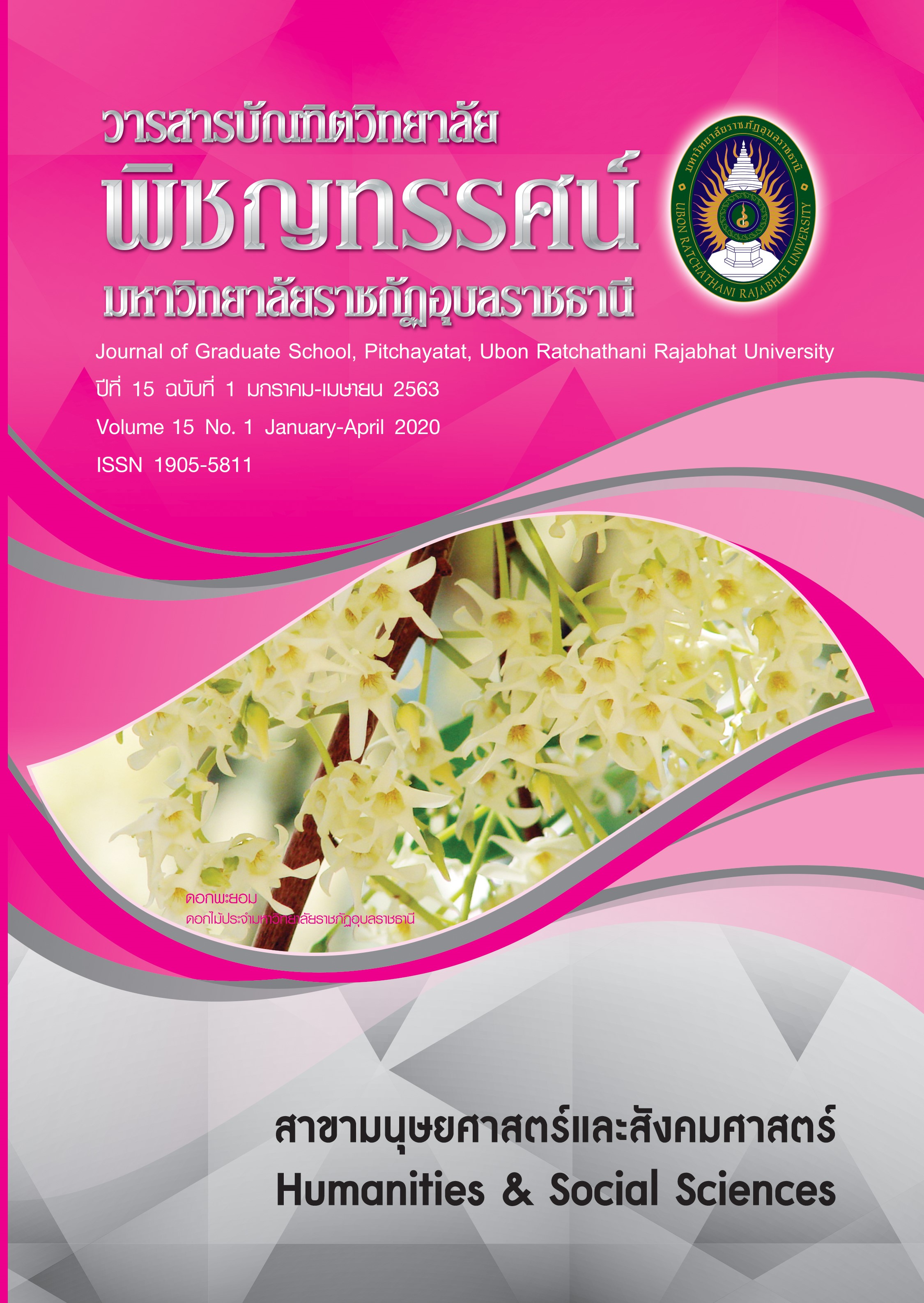การพัฒนารูปแบบการเรียนบนเว็บแบบผสมผสาน เพื่อเสริมสร้างการสื่อสารและร่วมมือทำงานในทักษะการเรียนรู้แห่งศตวรรษที่ 21
คำสำคัญ:
รูปแบบการเรียนแบบผสมผสานบนเว็บ, การสื่อสารและร่วมมือทำงาน, ทักษะการเรียนรู้แห่งศตวรรษที่ 21บทคัดย่อ
การวิจัยนี้มีวัตถุประสงค์เพื่อ 1) พัฒนารูปแบบการเรียนบนเว็บแบบผสมผสาน เพื่อเสริมสร้างการสื่อสารและร่วมมือทำงาน ในทักษะการเรียนรู้แห่งศตวรรษที่ 21 2) ศึกษาผลการใช้รูปแบบการเรียนบนเว็บแบบผสมผสาน เพื่อเสริมสร้างการสื่อสารและร่วมมือทำงานในทักษะการเรียนรู้แห่งศตวรรษที่ 21
ตัวอย่างที่ใช้ประกอบด้วย 1) นักศึกษาสถาบันบัณฑิตพัฒนศิลป์ จำนวน 320 คน โดยใช้วิธีสุ่มแบบกลุ่ม เมื่อได้สถาบันตัวแทนแต่ละภาคแล้วจึงกำหนดสัดส่วนจำนวนกลุ่มตัวอย่างในแต่ละภาค โดยใช้วิธีการสุ่มเชิงช่วงชั้นอย่างมีสัดส่วน 2) ผู้เชี่ยวชาญร่วมสนทนากลุ่ม 5 คน และผู้ทรงคุณวุฒิประเมินความถูกต้องและรับรองรูปแบบ 5 คน 3) นักศึกษาสถาบันบัณฑิตพัฒนศิลป์ จำนวน 32 คน และสถิติที่ใช้ ได้แก่ ร้อยละ ค่าเฉลี่ย ส่วนเบี่ยงเบนมาตรฐานและการทดสอบที
ผลการวิจัยพบว่า
- รูปแบบการเรียนแบบผสมผสานบนเว็บ เพื่อเสริมสร้างการสื่อสารและการร่วมมือทำงาน ในทักษะการเรียนรู้ในทศวรรษที่ 21 ผลการประเมินรูปแบบอยู่ในระดับเหมาะสมมากที่สุด องค์ประกอบของการเรียนบนเว็บแบบผสมผสานแบบร่วมมือบนเว็บ คือ 1) หลักการของรูปแบบ 2) วัตถุประสงค์ 3) กระบวนการเรียนการสอน 4) การวัดและประเมินผล ขั้นตอนการเรียนบนเว็บแบบผสมผสานแบบร่วมมือบนเว็บ คือ 1) ขั้นเตรียมความพร้อมก่อนการเรียน 2) ขั้นจัดกิจกรรมการเรียน 3) ขั้นสรุปการเรียน กิจกรรมการเรียนการสอนบนเว็บแบบผสมผสานแบบร่วมมือบนเว็บ คือ 1) แจ้งวัตถุประสงค์ 2) ศึกษาเนื้อหา 3) วางแผนการเรียน 4) สืบค้นข้อมูล 5) วิเคราะห์ตรวจสอบ 6) นำเสนอผลการเรียน 7) ประเมินและเผยแพร่ การวัดและประเมินผล คือ 1) ผลสัมฤทธิ์ทางการเรียน 2) พฤติกรรมการสื่อสารและร่วมมือทำงาน
- ผลการใช้รูปแบบการเรียนแบบผสมผสานบนเว็บ เพื่อเสริมสร้างการสื่อสารและการร่วมมือทำงาน ในทักษะการเรียนรู้ในทศวรรษที่ 21 ผลการศึกษาผลสัมฤทธิ์ทางการเรียนผู้เรียนที่เรียนแบบผสมผสานบนเว็บ พบว่า คะแนนผลสัมฤทธิ์ทางการเรียนของผู้เรียนหลังเรียนสูงกว่าก่อนเรียนอย่างมีนัยสำคัญทางสถิติที่ระดับ .05
เอกสารอ้างอิง
จินตวีร์ คล้ายสังข์. การออกแบบเว็บเพื่อการเรียนการสอน แนวทางการประยุกต์ใช้สำหรับการเรียนแบบผสมผสาน อีเลิร์นนิง. กรุงเทพฯ: โรงพิมพ์แห่งจุฬาลงกรณ์มหาวิทยาลัย, 2559.
ใจทิพย์ ณ สงขลา. การออกแบบการเรียนแนวดิจิทัล. กรุงเทพฯ: ศูนย์ตำราและเอกสารทางวิชาการ คณะครุศาสตร์ จุฬาลงกรณ์มหาวิทยาลัย, 2561.
ณัฐวุฒิ ภูมิพันธุ์. การพัฒนาโมเดลการฝึกอบรมแบบร่วมมือบนเว็บ เพื่อเสริมสร้างสมรรถภาพด้านเทคโนโลยีสารสนเทศและการสื่อสาร สำหรับนักศึกษาสถาบันบัณฑิตพัฒนศิลป์. วิทยานิพนธ์ปรัชญาดุษฎีบัณฑิต มหาวิทยาลัยมหาสารคาม, 2558.
ทิศนา แขมมณี. ศาสตร์การสอน. พิมพ์ครั้งที่ 22. กรุงเทพฯ: ด่านสุทธาการพิมพ์, 2561.
นวลพรรณ ไชยมา. การพัฒนารูปแบบการจัดการเรียนการสอนแบบผสมผสานโดยการประยุกต์ใช้เทคโนโลยีสารสนเทศเพื่อพัฒนาทักษะการคิดขั้นสูงสำหรับนักศึกษาสถาบันการพลศึกษาวิทยาเขตเพชรบูรณ์. วิทยานิพนธ์ปรัชญาดุษฎีบัณฑิต มหาวิทยาลัยขอนแก่น, 2554.
บุญเลิศ คณาธนสาร. การสื่อสารอย่างมีตรรกะ. (ออนไลน์) 2561 (อ้างเมื่อ 21 เมษายน 2561). จาก https://www.oknation.net/blog/print.php?id=826433>
ประวิทย์ สิมมาทัน. การพัฒนารูปแบบการเรียนการสอนแบบร่วมมือบนเครือข่ายคอมพิวเตอร์ สำหรับนักศึกษาระดับปริญญาตรี โดยอาศัยแนวทฤษฏีคอนสตรัคติวิสต์. วิทยานิพนธ์ปรัชญาดุษฎีบัณฑิต มหาวิทยาลัยเทคโนโลยีพระจอมเกล้าพระนครเหนือ, 2552.
ปณิตา วรรณพิรุณ. การพัฒนารูปแบบการเรียนการสอนบนเว็บแบบผสมผสานโดยใช้ปัญหาเป็นหลักเพื่อพัฒนาการคิดอย่างมีวิจารณญาณของนิสิตปริญญาบัณฑิต. วิทยานิพนธ์ดุษฎีบัณฑิต จุฬาลงกรณ์มหาวิทยาลัย, 2551.
พีรศักดิ์ กิ่งพุ่ม. การพัฒนาโมเดลการเรียนรู้ร่วมกันแบบผสมผสาน เพื่อพัฒนาผลสัมฤทธิ์ทางการเรียน และความสามารถในการคิดของนักศึกษาระดับปริญญาตรี สถาบันการพลศึกษา. วิทยานิพนธ์ปรัชญาดุษฎีบัณฑิต มหาวิทยาลัยมหาสารคาม, 2557.
วิจารณ์ พานิช. การสร้างการเรียนรู้สู่ศตวรรษที่ 21. กรุงเทพฯ: มูลนิธิสยามกัมมาชล, 2556.
วิจารณ์ พานิช. วิถีสร้างการเรียนรู้เพื่อศิษย์ในศตวรรษที่ 21. กรุงเทพฯ: มูลนิธิสดศรี-สฤษดิ์วงศ์, 2555.
วีณา ประชากูล และ ประสาท เนืองเฉลิม. รูปแบบการเรียนการสอน. พิมพ์ครั้งที่ 2. มหาสารคาม: สำนักพิมพ์มหาวิทยาลัยมหาสารคาม, 2554.
ศึกษาธิการ, กระทรวง. แผนแม่บทเทคโนโลยีสารสนเทศเพื่อการศึกษา กระทรวงศึกษาธิการ พ.ศ. 2550-2554. กรุงเทพฯ: กระทรวงศึกษาธิการ, 2550.
สุทธิชัย ปัจจโรจน์. การนำเสนออย่างมีตรรกะ. (ออนไลน์) 2561 (อ้างเมื่อ 21 เมษายน 2561).
จาก https://www.oknation.net/blog/print.php?id=859198> 2556.
สุรศักดิ์ ปาเฮ. กระบวนทัศน์เทคโนโลยีการศึกษาในยุคดิจิทัล. แพร่: แพร่ไทยอุตสาหกรรมการพิมพ์, 2560.
Krejcie, R. V., and Morgan, D. W. “Determining sample size for research activities,” Educational and Psychological Measurement. 30, 3 (1970): 607-610.
Senge, Peter M. The fifth discipline Fieldbook. New York: doubleday/Currence, 1994.
ดาวน์โหลด
เผยแพร่แล้ว
รูปแบบการอ้างอิง
ฉบับ
ประเภทบทความ
สัญญาอนุญาต
บทความทุกเรื่องได้รับการตรวจความถูกต้องทางวิชาการโดยผู้ทรงคุณวุฒิภายนอกอย่างน้อย 3 คน ความคิดเห็นในวารสารพิชญทรรศน์เป็นความคิดเห็นของผู้นิพนธ์มิใช่ความคิดเห็นของผู้จัดทำ จึงมิใช่ความรับผิดชอบของวารสารพิชญทรรศน์ และบทความในวารสารพิชญทรรศน์สงวนสิทธิ์ตามกฎหมายไทย การจะนำไปเผยแพร่ต้องได้รับอนุญาตเป็นลายลักษณ์อักษรจากกองบรรณาธิการ





